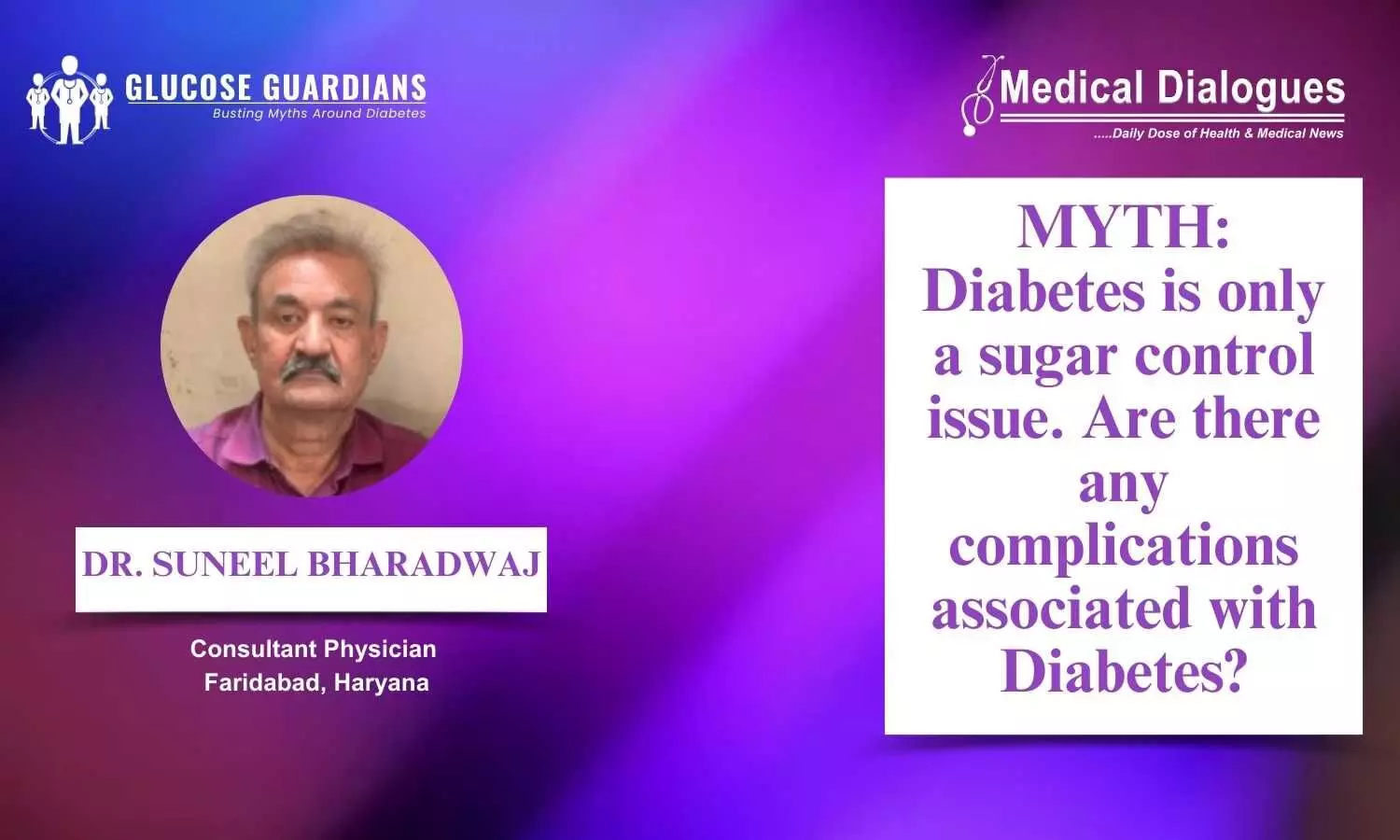Anorexia nervosa can be life-threatening in males
Powered by WPeMatico
Powered by WPeMatico
Powered by WPeMatico
Powered by WPeMatico

Lower HbA1c levels are associated with reduced risks of heart disease, kidney problems, nerve damage, and eye issues. Achieving this target helps improve overall quality of life and ensures better control over diabetes-related complications. However, individualized treatment goals may vary, and it’s essential to consult a healthcare professional to determine the most appropriate target for each person with diabetes.
Contrary to the myth that diabetes is solely a sugar control issue, it involves a range of complications. Prolonged high blood sugar levels can lead to serious issues such as heart disease, kidney problems, nerve damage, vision impairment, and even amputations. It affects the entire body, highlighting the importance of comprehensive diabetes management, including lifestyle changes, medication, and regular monitoring, to prevent these complications and maintain overall health.
In this video, Dr Suneel Bhardwaj, General Physician from Delhi, discusses why it is important for people with diabetes to maintain HbA1C below 7%. He dispels the myth that diabetes is merely a sugar control issue.
Powered by WPeMatico

Pfizer’s drug to treat patients with an inflammatory bowel disease called ulcerative colitis has been approved by the European Commission, the company said on Monday.
Powered by WPeMatico

USA: A recent article published in The Journal of the American Dental Association has reported key recommendations and good practice statements for the pharmacologic management of acute dental pain: postoperative pain after simple and surgical tooth extraction(s) in adolescents, adults, and older adults.
The document stated, that there is a beneficial net balance favoring the use of nonopioid medications compared with opioid medications. In particular, nonsteroidal anti-inflammatory drugs alone or in combination with acetaminophen likely provide superior pain relief with a more favourable safety profile than opioids.
The evidence-based recommendations were formulated by a panel convened by the American Dental Association Science and Research Institute, the University of Pennsylvania, and the University of Pittsburgh. For recommendations formulation, the panel used the Grading of Recommendations, Assessment, Development and Evaluation approach to assess the certainty of the evidence and the Grading of Recommendations, Assessment, Development and Evaluation Evidence-to-Decision Framework.
Nonopioid medications are first-line therapy for managing acute dental pain after tooth extraction(s) and the temporary management of toothache.
“The use of opioids should be reserved for clinical situations when the first-line therapy is insufficient to reduce pain or there is a contraindication of nonsteroidal anti-inflammatory drugs,” the panel stated.
“Clinicians should avoid the routine use of just-in-case prescribing of opioids and should exert extreme caution when prescribing opioids to adolescents and young adults.”
The key recommendations are described below:
Good Practice Statements
Reference:
Carrasco-Labra, A., Polk, D. E., Urquhart, O., Aghaloo, T., Claytor, J. W., Dhar, V., Dionne, R. A., Espinoza, L., Gordon, S. M., Hersh, E. V., Law, A. S., Li, B. S. K., Schwartz, P. J., Suda, K. J., Turturro, M. A., Wright, M. L., Dawson, T., Miroshnychenko, A., Pahlke, S., . . . Moore, P. A. (2024). Evidence-based clinical practice guideline for the pharmacologic management of acute dental pain in adolescents, adults, and older adults: A report from the American Dental Association Science and Research Institute, the University of Pittsburgh, and the University of Pennsylvania. The Journal of the American Dental Association, 155(2), 102-117.e9. https://doi.org/10.1016/j.adaj.2023.10.009
Powered by WPeMatico

Carbapenem-resistant Enterobacterales species and multidrug-resistant Pseudomonas aeruginosa pose significant global health threats. Cefepime–taniborbactam is an investigational β-lactam and β-lactamase inhibitor combination with activity against these organisms.
Powered by WPeMatico

South Korea: A recent study published in The Journal of Dermatology evaluated the effects of treatment regimens in Asian breast cancer (BC) patients.
The researchers revealed significantly increased odds of experiencing elevated hair loss, a higher melanin index & increased wrinkles six months post-surgery in those in the adjuvant treatment group, particularly those undergoing taxane-based chemotherapy. In the neoadjuvant treatment group, the researchers observed a reversal of hair loss in most patients after the surgery.
With the increasing number of young breast cancer patients worldwide, concerns about skin change and hair loss persist among cancer survivors.
Taxanes (paclitaxel and docetaxel) are among the most commonly prescribed anticancer drugs approved for the treatment of metastatic or locally advanced breast, gastric, non-small cell lung, prostate, head and neck, and ovarian cancers, as well as in the adjuvant setting for operable node-positive breast cancers.
The true incidence of dermatological adverse events (AEs) in patients receiving taxanes is unknown and has not been prospectively analysed, but they represent one of the major AEs associated with these agents. With an increase in the occurrence of cutaneous adverse events during treatment with novel targeted and immunological therapies when used along with taxanes, it is imperative to thoroughly understand the reactions attributable to this class. Moreover, identification and management of dermatological AEs is critical for maintaining the quality of life in cancer patients and for minimizing dose modifications of their antineoplastic regimen.
Against the above background, Joonho Shim, Sungkyunkwan University School of Medicine, Seoul, Republic of Korea, and colleagues aimed to evaluate the skin changes and hair loss in Asian breast cancer patients and to compare them according to the treatment regimens.
Three hundred and twenty-two patients scheduled to undergo breast cancer surgery were enrolled. Skin changes and hair loss were assessed at the following two-time points: one day before surgery and six months after surgery.
Patients who had received systemic anticancer treatment prior to surgery were assigned to the neoadjuvant treatment group, while patients who were scheduled to receive systemic anticancer treatment were assigned to the adjuvant treatment group.
The key findings of the study were as follows:
“Clinicians should inform breast cancer patients about the potential for hair loss and skin changes and provide supportive care to mitigate the effects on the patient’s quality of life,” the researchers concluded.
Reference:
Shim, J., Noh, H., Kim, H., Joo, B., Lee, J., Oh, S. J., Lee, J. H., Lee, D., Lee, S. K., & Park, J. Assessment of hair loss and skin changes during treatment in Asian breast cancer patients: A prospective cohort study. The Journal of Dermatology. https://doi.org/10.1111/1346-8138.17092
Powered by WPeMatico

Cardio-Oncology Patients may have high prevalence of sleep apnea and risk of CHF suggests a new study published in the American College of Cardiology.
Sleep apnea is prevalent among patients at higher risk for developing congestive heart failure (CHF) following cancer treatment and could be used as a risk factor to identify patients who would benefit from earlier treatment, according to a study being presented at ACC’s Advancing the Cardiovascular Care of the Oncology Patient course. Obstructive sleep apnea (OSA), the focus of this study, has a prevalence of 48-52% among patients with CHF in the general population. To determine the prevalence of OSA in cardio-oncology patients, researchers administered the STOP-BANG questionnaire, a well-established screening tool for sleep apnea, among 218 cardio-oncology patients and 296 general cardiology patients. Data were collected on traditional risk factors, STOP-BANG scores and history of sleep for both groups. Baseline echocardiogram left ventricular ejection fraction (LVEF)and Global Longitudinal LV Strain (GLS) results were measured for the cardio-oncology population. Other research has shown that LVEF and GLS can predict early cancer-therapy-related cardiomyopathy, and OSA is also linked to LV dysfunction, CHF and abnormal LV-GLS. “Echocardiogram has evolved to be a useful tool to detect and therefore treat cardiomyopathy early in patients with sleep apnea and in the cardio-oncology population, so we also wanted to see if there are shared echo markers that identify patients who are at greater risk as they start their journey to treat their cancer,” says Mini K. Das, MD, FACC, medical director of the cardio-oncology program at Baptist Health in Louisville, KY, and the study’s primary author. Results showed that the incidence of sleep apnea was 39% in the cardio-oncology group and 54% in the general cardiology group. The researchers note that individuals with untreated sleep apnea and those at higher risk for sleep apnea have abnormal baseline LV strain, a common echo parameter linked to adverse cardiovascular events. “Identifying these individuals may allow early intervention in a risk factor clearly associated with HF now recognized to affect cancer therapy and survivorship,” Das says. Notably, the study showed that the prevalence of sleep apnea in the cardio-oncology group was equal to or greater than other traditional risk factors used in current risk factor profile algorithms and that LV GLS was more abnormal in patients with untreated sleep apnea or a high STOP-BANG score. “Sleep apnea should be incorporated into current risk algorithms and a larger study is needed to evaluate the impact of sleep apnea in this high-risk population. We feel that sleep apnea assessment must be a part of routine risk assessment for patients undergoing cancer therapeutics,” says Das. Advancing the Cardiovascular Care of the Oncology Patient, being held Feb. 9 to 11, is an interdisciplinary course that highlights emerging strategies and best practices for managing the heart health of cancer patients.
Reference:
Sleep Apnea a Risk Factor For Heart Failure From Cancer Therapy. Feb 09, 2024. ACC News Story
Keywords:
Cardio-Oncology Patients, high prevalence, sleep apnea, risk of CHF
Powered by WPeMatico

China: A recent study published in Frontiers in Endocrinology has identified an association between haemoglobin (Hb) levels and bone mineral density (BMD) and 10-year fracture risk among a population with type 2 diabetes (T2D).
The study provided a new perspective on the association of Hb level and BMDs with fracture risk.
The study further revealed that relatively high haemoglobin levels protected bone quality in an older male population with type 2 diabetes, but lower Hb levels were associated with lower BMD and high future fracture risk in a non-older female population with T2D.
“The bone-protective effect of haemoglobin is influenced by sex and age and persists only in older men and non-older women with T2DM,” the researchers wrote.
Osteoporosis is a disease characterized by weaker, more fragile bones, and lowered bone density—patients with diabetes experience an increased osteoporosis risk, particularly in the Asian population. Anaemia incidence is also higher in T2D patients compared with the general population. Previous research has identified an association between anaemia and osteoporosis in people with T2D, irrespective of sex and without stratification by age.
Against the above background, Ren-xuan Li, Shandong University, Jinan, Shandong, China, and colleagues aimed to investigate the associations between haemoglobin Levels and BMD and fracture risk in type 2 diabetes populations of different ages.
For this purpose, they conducted a cross-sectional study comprising 641 patients with T2DM (57.9% males). BMD of the femoral neck (FN), lumbar spine (LS), and total hip (TH) were measured using dual-energy X-ray absorptiometry.
The 10-year probability of fracture was evaluated using a fracture risk assessment tool (FRAX). Haemoglobin and other biochemical indices were measured in a certified laboratory at a hospital. Generalized additive models (GAMs) were used to identify the associations between Hb and BMD and fracture risk.
The study led to the following findings:
“The present study showed for the first time that lower haemoglobin levels are associated with lower FN and TH BMD in older male T2D population and that lower Hb levels are associated with lower BMD and higher future fracture risk in a non-older female T2D population,” the researchers wrote. “Relatively low HGB levels in this population may be an independent risk factor for osteoporosis and osteoporotic fractures.”
“There is a need for further studies to confirm these results and investigate the potential mechanisms,” they concluded.
Reference:
Li R-x, Xu N, Guo Y-n, Wang Y, Liang Y-w, Zhou X-l, Jiang W-t, Wei J-x, Zhang X-y, Zhou L-n, Zhu L, Zhou Y-m and Xu J (2024) Hemoglobin is associated with BMDs and risk of the 10-year probability of fractures in patients with type 2 diabetes mellitus. Front. Endocrinol. 15:1305713. doi: 10.3389/fendo.2024.1305713
Powered by WPeMatico
